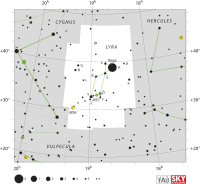
Photo from wikipedia
A seven-parameter distribution function (DF) is fitted to 20 000 RR-Lyrae stars for which only astrometric data are available. The observational data are predicted by the DF in conjunction with the… Click to show full abstract
A seven-parameter distribution function (DF) is fitted to 20 000 RR-Lyrae stars for which only astrometric data are available. The observational data are predicted by the DF in conjunction with the gravitational potential of a self-consistent model Galaxy defined by DFs for the dark halo, the bulge and a four-component disc. Tests of the technique developed to deal with missing line-of-sight velocities show that adding such velocities tightens constraints on the DF only slightly. The recovered model of the RR-Lyrae population confirms that the population is flattened and has a strongly radially biased velocity distribution. At large radii its density profile tends to ρ ∼ r−4.5 but no power law provides a good fit inside the solar sphere. The model is shown to provide an excellent fit to the data for stars brighter than r = 16.5 but at certain longitudes it predicts too few faint stars at Galactocentric radii ∼20 kpc, possibly signalling that the halo is not axisymmetric. The DF is used to predict the velocity distribution of BHB stars for which space velocities are available. The z components are predicted successfully but too much anisotropy in the vRvφ plane is expected.
Journal Title: Monthly Notices of the Royal Astronomical Society
Year Published: 2021
Link to full text (if available)
Share on Social Media: Sign Up to like & get
recommendations!